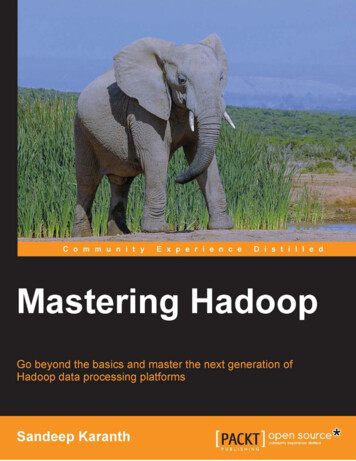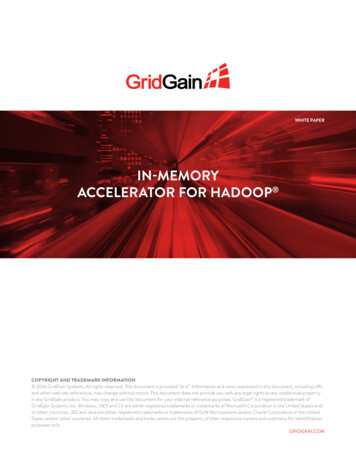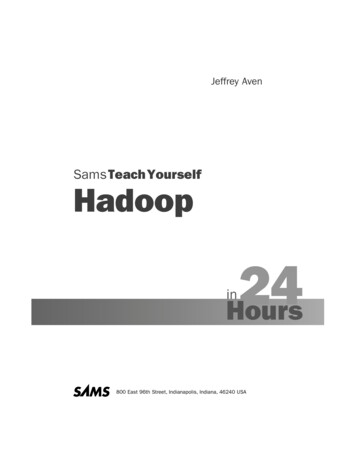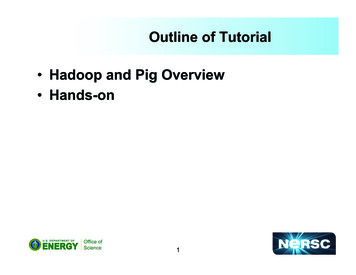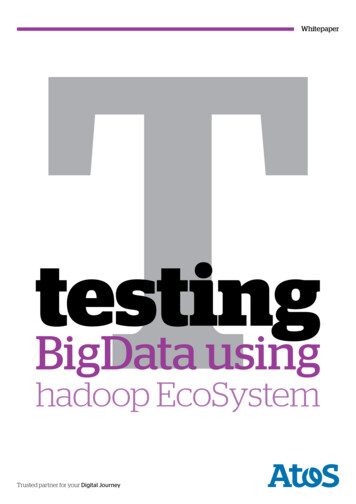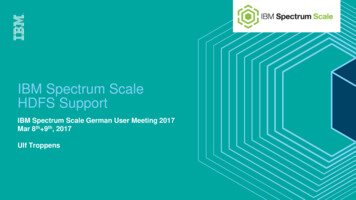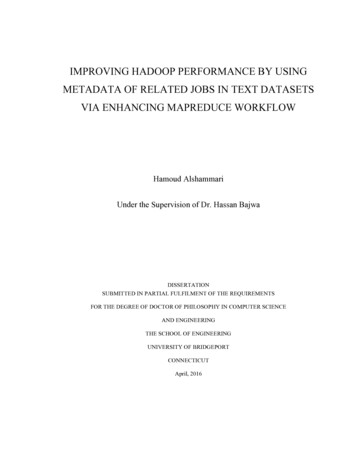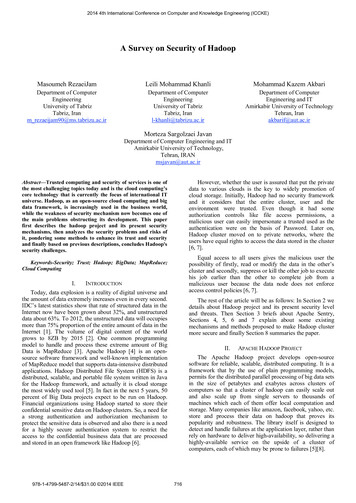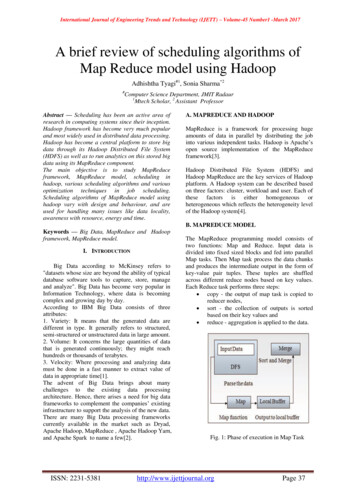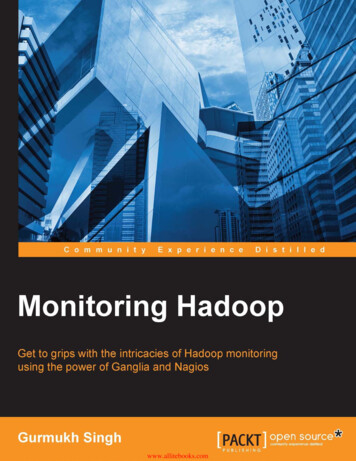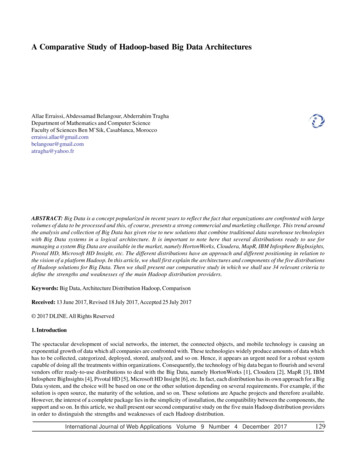
Transcription
A Comparative Study of Hadoop-based Big Data ArchitecturesAllae Erraissi, Abdessamad Belangour, Abderrahim TraghaDepartment of Mathematics and Computer ScienceFaculty of Sciences Ben M’Sik, Casablanca, atragha@yahoo.frABSTRACT: Big Data is a concept popularized in recent years to reflect the fact that organizations are confronted with largevolumes of data to be processed and this, of course, presents a strong commercial and marketing challenge. This trend aroundthe analysis and collection of Big Data has given rise to new solutions that combine traditional data warehouse technologieswith Big Data systems in a logical architecture. It is important to note here that several distributions ready to use formanaging a system Big Data are available in the market, namely HortonWorks, Cloudera, MapR, IBM Infosphere BigInsights,Pivotal HD, Microsoft HD Insight, etc. The different distributions have an approach and different positioning in relation tothe vision of a platform Hadoop. In this article, we shall first explain the architectures and components of the five distributionsof Hadoop solutions for Big Data. Then we shall present our comparative study in which we shall use 34 relevant criteria todefine the strengths and weaknesses of the main Hadoop distribution providers.Keywords: Big Data, Architecture Distribution Hadoop, ComparisonReceived: 13 June 2017, Revised 18 July 2017, Accepted 25 July 2017 2017 DLINE. All Rights Reserved1. IntroductionThe spectacular development of social networks, the internet, the connected objects, and mobile technology is causing anexponential growth of data which all companies are confronted with. These technologies widely produce amounts of data whichhas to be collected, categorized, deployed, stored, analyzed, and so on. Hence, it appears an urgent need for a robust systemcapable of doing all the treatments within organizations. Consequently, the technology of big data began to flourish and severalvendors offer ready-to-use distributions to deal with the Big Data, namely HortonWorks [1], Cloudera [2], MapR [3], IBMInfosphere BigInsights [4], Pivotal HD [5], Microsoft HD Insight [6], etc. In fact, each distribution has its own approach for a BigData system, and the choice will be based on one or the other solution depending on several requirements. For example, if thesolution is open source, the maturity of the solution, and so on. These solutions are Apache projects and therefore available.However, the interest of a complete package lies in the simplicity of installation, the compatibility between the components, thesupport and so on. In this article, we shall present our second comparative study on the five main Hadoop distribution providersin order to distinguish the strengths and weaknesses of each Hadoop distribution.International Journal of Web Applications Volume 9 Number 4 December 2017129
2. Hadoop Distributions of the Big DataThere are several distributions that permit to manipulate a Big Data system and to manage its main components: HortonWorks,Cloudera, MapR, IBM Infosphere BigInsights, Pivotal, Microsoft HDInsight, etc. In this part, we shall talk about the four bestknown and used distributions in the world of Big Data. These are: HortonWorks, Cloudera, Pivotal HD, and IBM InfosphereBigInsights.2.1 HortonWorks DistributionIn 2011, members of the Yahoo team in charge of the Hadoop project formed HortonWorks. All components of this distributionare open source and licensed from Apache so as to facilitate the adoption of the Apache Hadoop platform. HortonWorks is a bigHadoop contributor, and its economic model is not for the purpose of selling a license but of selling exclusively support andtraining. This distribution is most consistent with Apache’s Hadoop platform.Figure 1. HortonWorks Hadoop Platform (HDP) [1]The following elements make up the HortonWorks platform [1]: Heart Hadoop (HDFS/MapReduce) [10] Querying (Apache Hive [11]) Integration services (HCatalog APIs [13], WebHDFS, Talend Open Studio for Big Data [14], Apache Sqoop [12]) NoSQL (Apache HBase [15]) Planning (Apache Oozie [16]) Distributed Log Management (Apache Flume [17]) Metadata (Apache HCatalog [13]) Coordination (Apache Zookeeper [18]) Learning (Apache Mahout [19]) Script Platform (Apache Pig [20]) Management and supervision (Apache Ambari [21])130International Journal of Web Applications Volume 9 Number 4 December 2017
2.2 Cloudera DistributionCloudera was firstly founded by Hadoop experts from Facebook, Google, Oracle and Yahoo. This distribution is largely basedon the components of Apache Hadoop and it is complemented by essentially house components for cluster management. Theaim of Cloudera’s business model is not only to sell Licenses but to sell support and training as well. Cloudera offers a fully opensource version of their platform (Apache 2.0 license) [2].Figure 2. Cloudera Distribution for Hadoop Platform (CDH) [2]2.3 IBM InfoSphere BigInsights DistributionInfoSphere BigInsights for Hadoop was firstly introduced in 2011 in two versions: the Enterprise Edition and the basic version,which was a free download of Apache Hadoop bundled with a web management console. In June 2013, IBM launched theInfosphere BigInsights Quick Start Edition. This new edition provided massive data volume analysis capabilities on a businesscentric platform [4]. It both combines Apache Hadoop’s Open Source solution with enterprise functionality and hence, providesa large-scale analysis, characterized by its resilience and fault tolerance. In short, this distribution supports structured, unstructuredand semi-structured data and offers maximum flexibility.2.4 Pivotal HD DistributionPivotal Software, Inc. (Pivotal) is a software and services company based in San Francisco and Palo Alto, California, with severalother offices. The divisions include Pivotal Labs for consulting services, the Pivotal Cloud Foundry development group, and aproduct development group for the Big Data market. In March 2013, an Apache Hadoop distribution called Pivotal HD wasannounced, including a version of Greenplum software [24] called Hawq. Pivotal HD Enterprise is a commercially supporteddistribution of Apache Hadoop [5]. The figure below shows how each Apache and Pivotal component integrates into the overallarchitecture of Pivotal HD Enterprise:3. Comparison between DistributionsIn effect, we earlier carried out a comparative study of the Hadoop distributions architecture of Big Data for the purpose ofmaking an evaluation between the distributions. Our main goal was to identify the strengths and weaknesses of the five majorHadoop distribution providers: Cloudera, HortonWorks, IBM InfoSphere BigInsights, MapR and Pivotal HD. Indeed, this workis an advanced analysis of the first comparative study we made before [27]. We based our work on three principal studies. Thefirst one is the evaluation made by Forrester Wave [7] of the same Hadoop distributions, in which they used 35 evaluationcriteria grouped into three high-level buckets: Current Offering, Strategy, and Market presence. The two other comparativestudies are those proposed by Robert D. Schneider [8] and V.Starostenkov [9] on the three HortonWorks, Cloudera, and MapRdistributions.International Journal of Web Applications Volume 9 Number 4 December 2017131
Figure 3. IBM InfoSphere BigInsights Entreprise Edition [4]Figure 4. Pivotal HD Entreprise [5]132International Journal of Web Applications Volume 9 Number 4 December 2017
In this analysis, we shall propose 34 relevant criteria to try to distinguish and differentiate the different architectures availablefor the five distributions of Big Data solutions.3.1 Criteria for ComparisonTo compare the five distributions, we shall use the following criteria: Disaster Recovery: It can help prevent data loss in the event of a computer center failure. It has the possibility to rebuild theinfrastructure and to restart applications that support the activity and survival of a company. Therefore, Disaster Recovery mustbe able to take care of the computer needs necessary for the survival of the organization in case of a Big Data system disaster. Replication: In order to improve reliability, fault tolerance, and availability, the different Big Data Hadoop distributions use aprocess of information sharing to ensure data consistency across multiple redundant data sources. Data replication is called ifthe data is duplicated on multiple storage locations. Management Tools: These are management consoles used by different Hadoop solution providers to manage a Hadoopdistribution. Thanks to these tools, you can effortlessly deploy, configure, automate, report, track, troubleshoot, and maintaina Big Data system. Data and Job Placement Control: It allows to control the placement of data and jobs on a Hadoop cluster and, hence, permetsto choose nodes to execute jobs presented by different users and groups. Heatmaps, Alarms, Alerts: These are tools and notifications that allow to keep a global view of our Big Data system. The termHeatmap means a graphical representation of the data as a color, and a color block represents each host in the cluster. DFS: c’est le système de fichiers distribué pour le stockage. Security ACLs: It is a list of permissions attached to an object. An ACL specifies processes or system users which are allowedto access objects, and define clearly permissible operations on the object. Data Ingestion: Data Ingestion is the process of importing and obtaining data for immediate use or storage in a database orHDFS. Thus, Data can be broadcast in real time or ingested in batches. When it is ingested in real time, it is imported as it istransmitted by the source. However, when data is ingested in batches, it is imported in discrete blocks at periodic time intervals. MetaData Architecture: here we shall talk about two types of architectures used by the Hadoop distributions at MetaDatalevel. The first one is a centralized architecture where everyone depends on the same authority. The second one is a decentralizedarchitecture that has no center, no more and no less. This means that every entity can be a part of a network that has no mainauthority and that these authorities can talk to each other. MapReduce: It is the dedicated programming model for making parallel and distributed computations of potentially very largedata. Apache Hadoop YARN [25] (Yet Another Resource Negotiator) is a technology for managing clusters and making Hadoop moresuitable for operational applications that cannot wait for the completion of batch processing. YARN is among the key featuresof Hadoop 2, the second generation of the distributed processing infrastructure of Apache Software Foundation. Non-Relational Data Base: These are databases that do not include the key/table model that relational database managementsystems (RDBMS) use. These databases put into action data manipulation techniques and dedicated processes so as toprovide solutions to the major data issues that great organizations are confronted with. The most popular emerging nonrelational database is NoSQL (Not Only SQL). Meta Data Services: It is an object-oriented reference technology that can be integrated into enterprise information systemsor into applications that use the MetaData process. Scripting Platforms: These are dedicated platforms for programming languages that use high-level constructs to interpret andInternational Journal of Web Applications Volume 9 Number 4 December 2017133
execute one command at a time. Data Access and Query: queries are utilized by users to express their information needs and to access data. Workflow Scheduler: It is a representation of a sequence of operations or tasks carried out by a person, a group of people oran organization. It refers to the passage of information from one episode to another. Coordination Cluster: In order to avoid gaps and overlaps in Cluster work, coordination aims to ensure a coherent andcomplementary approach by identifying ways to work together for the purpose of achieving better collective outcomes. Bulk Data Transfer between RDB and Hadoop: These are tools designed to efficiently transfer data between Apache Hadoopand structured data stores such as relational databases. Machine Learning: It concerns the analysis, design, development, and implementation of methods that allow a machine toevolve through a systematic process, and consequently, to solve problems by more conventional algorithmic means.Data Analysis: It allows to process a large number of data and to identify the most interesting aspects of the structure of thesedata. Besides, it eventually provides graphical representations which can reveal relations that are difficult to grasp by the directdata analysis. Cloud Services: These are the dedicated services to exploit the computing and storage power of remote computer servers viaa network that is the internet. Cloud services are characterized by their great flexibility. Parallel Query Execution Engine: These are parallel query execution engines, intending to optimize the execution of queriesand indexes. Full-text Search: It is a search technique in a document or database on all the words. This technique tries to match the wordsto those provided by the users. Data Warehousing: Means a database used to collect, order, log and store information from operational databases. It alsoprovides a basis for business decision support. Extract, Transform and Load (ETL): It is a computer technology known as ETL that allows massive synchronization ofinformation from one data source to another. Authentication: It is a process allowing access to the resources of an information system by an entity. It permits the system tovalidate the legitimacy of the access of the entity. After this, the system assigns this entity the identity data for that session. Authorization: It determines whether the authenticated subject can place the desired action on the specified object. Accountability: It is an obligation to report and explain, with an idea of transparency and traceability, by identifying anddocumenting the measures implemented mainly for the purpose of complying with the requirements of the IT and freedomsregulations. Data Protection: It urges the data controller in the Big Data distributions to adopt internal rules and to implement appropriatemeasures to guarantee and demonstrate that the processing of personal data is carried out in compliance with the IT regulationsand freedoms. Provise, Manage & Monitor: These are tools for configuration management, management and monitoring of the computersystem. Provisioning allows you to remotely install and configure software, allocate disk space, power, or memory. Monitoringis the permanent monitoring of the computer system for a preventive purpose. It allows it to be alerted in case of abnormaloperations detections. Scheduler: It to define the links between the processes and the way to launch them. The notion of processing can be quite134International Journal of Web Applications Volume 9 Number 4 December 2017
general since it is any executable command on one or more computing machines.3.2 ComparisonThis table clusters the comparative study carried out as well as the results for each Hadoop distribution.Table 1. Comparison between the five distributions Hadoop for Big Data4. DiscussionPrior to starting our discussion, it is of utmost importance to point out briefly that several large organizations have contributedto the establishment of several distributions only for the purpose of managing large Big Data and of drawing valuable informationdrowned in the mass.International Journal of Web Applications Volume 9 Number 4 December 2017135
Accordingly, we based our comparative study on these distributions, mainly on the architectures of the different Hadoopdistribution providers in the Big Data. We rely on 34 relevant criteria that must have any solution to manage and administerclusters, as well as to collect, sort, categorize, move, analyze, store, and process Big Data. At this point we eventually draw someconclusions. Firstly, we found out that the majority of providers offer distributions based on Apache Hadoop and associatedopen source projects, and that they give a software solution that organizations can install on their own infrastructure on-site inprivate cloud and/or public cloud. We also found out that most of the five different distributions are based on the majority of thecriteria we have proposed and in this context, we deduce that there is not really an absolute winner in the market since eachsupplier focuses on main features dedicated to Big Data systems such as integration, security, scale, performance critical tobusiness adoption and governance.5. ConclusionIn short, The Big Data refers to the explosion of the volume of data in companies and to the technological means proposed bythe publishers to answer them. It also includes all the technologies for storing, analyzing and processing heterogeneous dataand content, in order to bring out added value and wealth. This trend around the collection and analysis of Big Data has givenrise to new distributions to manage a Big Data system. Seeing that there are several distributions that facilitate the adoption ofApache’s Hadoop platform and manage clusters namely Cloudera, HortonWorks, MapR, IBM Infosphere BigInsights, MicrosoftHD Insight, Pivotal HD, and so on. The work related to comparative studies will help us to detect the common features and thespecificities of the main Hadoop distributions of Big Data in order to try to standardize the concepts of Big Data in our nextworks.References[1] HortonWorks Data Platform HortonWorks Data Platform: New Book. (2015).[2] Menon, R. (2014). Cloudera Administration Handbook[3] Dunning, T., Friedman, E. (2015). Real-World Hadoop[4] Quintero, D. (n.d.). Front cover implementing an IBM InfoSphere BigInsights Cluster using Linux on Power.[5] Pivotal Software, I. (2014). Pivotal HD Enterprise Installation and Administrator Guide.[6] Sarkar, D. (2014). Pro Microsoft HDInsight. Berkeley, CA: Apress.[7] Read, W., Report, T., Takeaways, K. (2016). The Forrester WaveTM: Big Data Hadoop Distributions, Q1 2016.[8] Schneider, R. D. (2014). HADOOP BUYER’S GUIDE.[9] Starostenkov, V., Senior, R., Developer, D. (2013). Hadoop Distributions: Evaluating Cloudera, Hortonworks, and MapR inMicro-benchmarks and Real-world Applications.[10] Sawant, N., Shah, H. (Software engineer). (2013). Big data application architecture & A a problem-solution approach.Apress.[11] Capriolo, Edward, Wampler, Dean., Rutherglen, Jason. (2012). Programming Hive: Data Warehouse and Query Language forHadoop. 1 edition. Sebastopol, CA : O’Reilly Media.[12] Ting, Kathleen, Jarek Jarcec Cecho. (2013). Apache Sqoop Cookbook: Unlocking Hadoop for Your Relational Database. 1edition. Sebastopol, CA : O’Reilly Media.[13] Wall, L. (2015). About the Tutorial Copyright & Disclaimer, p. 2.[14] Barton, Daniel, Rick. (2013). Talend Open Studio Cookbook. Birmingham, UK : Packt Publishing, 2013.A[15] Vohra, Deepak. (2016). Apache HBase Primer. 1st ed. edition. New York, NY : Apress.[16] Islam, Kamrul, Mohammad., Srinivasan, Aravind. (2015). Apache Oozie: The Workflow Scheduler for Hadoop. 1 edition.Sebastopol: O’Reilly Media.[17] Hoffman, Steve. (2015). Apache Flume: Distributed Log Collection for Hadoop - Second Edition. 2nd edition. Birmingham,England; Mumbai, India: Packt Publishing - ebooks Account.136International Journal of Web Applications Volume 9 Number 4 December 2017
[18] Bagai, Chandan. (2016). Characterizing & Improving the General Performance of Apache Zookeeper: Sub-Project of ApacheHadoop. LAP LAMBERT Academic Publishing.[19] Lyubimov, Dmitriy, Palumbo, Andrew. (2016). Apache Mahout: Beyond MapReduce. 1 edition. CreateSpace IndependentPublishing Platform.[20] Gates, Alan, Dai, Daniel. (2016). Programming Pig: Dataflow Scripting with Hadoop. 2 edition. O’Reilly Media.[21] Eadline, Douglas. (2015). Hadoop 2 Quick-Start Guide: Learn the Essentials of Big Data Computing in the Apache Hadoop2 Ecosystem. 1 edition. New York: Addison-Wesley Professional.[22] Covert, Michael, Loewengart, Victoria. (2015). Learning Cascading. Birmingham: Packt Publishing - ebooks Account.[23] Dunning, Friedman, Ellen., Tomer Shiran Ted. (2016). Apache Drill: The SQL Query Engine for Hadoop and NoSQL. 1 edition.O’Reilly Media.[24] Gollapudi, Sunila. (2013). Getting Started with Greenplum for Big Data Analytics. Birmingham, UK: Packt Publishing.[25] Alapati, Sam, R. (2016). Expert Hadoop Administration: Managing, Tuning, and Securing Spark, YARN, and HDFS. 1 edition.Boston, MA: Addison-Wesley Professional.[26] Russell, John. (2014). Getting Started with Impala: Interactive SQL for Apache Hadoop. 1 edition. Sebastopol, CA: O’ReillyMedia.[27] Erraissi, Allae., Belangour, Abdessamad., Tragha, Abderrahim. (2017). A Big Data Hadoop Building Blocks ComparativeStudy.” International Journal of Computer Trends and Technology. Accessed June 18, 2017. .International Journal of Web Applications Volume 9 Number 4 December 2017137
2.4 Pivotal HD Distribution Pivotal Software, Inc. (Pivotal) is a software and services company based in San Francisco and Palo Alto, California, with seve ral other offices. The divisions include Pivotal Labs for consulting services, the Pivotal Cloud Foundry development group, and a product development group for the Big Data market.
